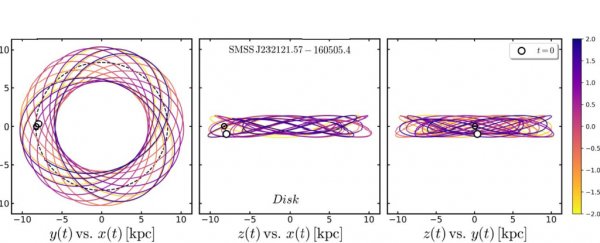Some of the Milky Way's oldest stars aren't where we expect them to be.
One of the ways we categorize stars is by their metallicity. That is the fraction of heavier elements a star has compared to hydrogen and helium. It's a useful metric because the metallicity of a star is a good measure of its age.
The hydrogen and helium we see in the Universe were created in the early moments of the Big Bang. That's why they are so plentiful. Heavier elements such as carbon and iron are created through astrophysical processes such as the fusion of elements in stellar cores, or during the collisions of white dwarfs and neutron stars.
Because of this, the earliest stars were made only of hydrogen and helium. Over time the abundance of heavier elements gradually increased, so younger stars tend to have a higher metallicity.
Since we can determine the metallicity of a star by observing its spectrum, we know the overall metallicity of stars, both in our galaxy and others. We can therefore group stars into metallicity "populations."
This is done by defining the hydrogen to iron ratio, [Fe/He], on a logarithmic scale setting our Sun as the zero point. Thus, Population I stars have a ratio of at least -1, meaning they have 10 percent or more of the Sun's [Fe/He] ratio.
 (Wikimedia Commons)
(Wikimedia Commons)
Older Population II stars have a lower metallicity than Population I, and Population III (the first generation stars) would have no metallicity at all.
In our galaxy, these populations of stars are distributed from the galactic plane outward. The youngest Population I stars tend to be within the spiral arms of our galaxy, while older Population II stars tend to be above or below the galactic plane. The diffuse outer halo of stars surrounding the Milky Way tends to be the stars lowest in metallicity.
This makes sense since stars are born within the dense gas and dust within the galactic plane, particularly the spiral arms. Over time, the gravitational dance of stars would allow them to migrate outward. Only older stars have had time to drift away from the plane.
But as ground-based sky surveys and the Gaia spacecraft give us a more detailed view of the Milky Way, it's revealing surprises about our long-held galactic model. This can be seen in a recent study looking at some of the oldest stars in our galaxy.
Using Australia's SkyMapper Southern Survey, the team identified 475 stars with a [Fe/He] ratio less than one-thousandth that of our Sun.
We would expect them to be halo stars, but when the team calculation the positions and orbits of these stars using data from Gaia they found that 11 percent of them orbit within the galactic plane.
Their orbits are also very circular, similar to the orbit of the Sun. This is surprising and goes against predictions of current galactic evolution models.
Large sky surveys of our galaxy are certain to revolutionize our understanding of the Milky Way. As even these early results show, it is clear we still have much to learn.
The research has been published in Monthly Notices of the Royal Astronomical Society.
This article was originally published by Universe Today. Read the original article.
